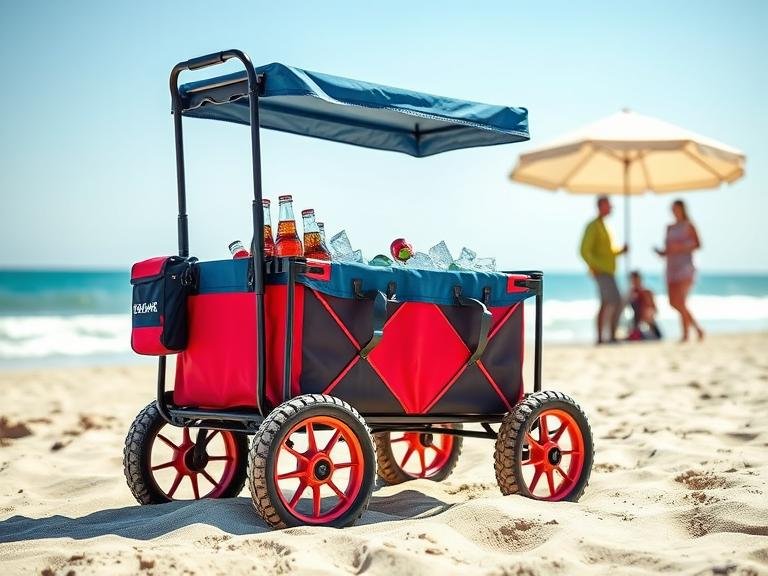When planning outdoor adventures, family gatherings, or beach trips, transporting food, drinks, and gear can become a logistical challenge. This is where a cooler wagon proves invaluable—combining the storage capacity of a traditional cooler with the mobility of a wagon. This innovative solution has transformed how people enjoy outdoor activities, making transportation effortless and efficient.
Table of Contents
What Makes Cooler Wagons Essential for Outdoor Activities
A cooler wagon represents a practical fusion of two essential outdoor tools. Unlike standard coolers that require carrying or dragging, these wheeled containers glide smoothly across various terrains. The design incorporates insulated compartments that maintain temperature while offering the convenience of easy movement, even when fully loaded.
The typical cooler wagon features durable wheels, often with all-terrain capabilities, ensuring smooth navigation across sand, grass, gravel, and pavement. The insulated interior keeps beverages cold and food fresh for hours, while the wagon structure allows for additional storage space beyond just cooling needs.
Key Features That Define Quality Cooler Wagons
Insulation Technology
The heart of any cooler wagon lies in its insulation system. High-quality models utilize thick foam insulation, sometimes reaching up to two inches, which creates an effective thermal barrier. This technology ensures that ice remains frozen longer and drinks stay refreshingly cold even during hot summer days.
Wheel Design and Maneuverability
Wheels make the fundamental difference between a cooler wagon and a traditional cooler. Most premium models feature wide, puncture-resistant wheels with deep treads. These wheels distribute weight evenly, preventing the wagon from sinking into soft surfaces like sand. Some advanced designs include swivel front wheels for enhanced maneuverability around tight corners and crowded spaces.
Capacity and Storage Options
Cooler wagons come in various sizes, typically ranging from 50 to 150 liters in capacity. Beyond the insulated compartment, many models include external pockets, mesh holders, and attachment points for umbrellas or poles. This additional storage accommodates towels, sunscreen, toys, and other essentials that don’t require cooling.
Practical Applications for Cooler Wagons
Beach Adventures
Beach trips become significantly easier with a cooler wagon. Instead of making multiple trips from the parking lot to your beach spot, everything travels in one convenient load. The wide wheels prevent sinking into sand, and the capacity accommodates coolers, umbrellas, chairs, and beach toys simultaneously.
Sporting Events and Tailgating
Sports enthusiasts appreciate how cooler wagons simplify tailgating experiences. These wagons hold enough refreshments for an entire group while providing easy transport from parking areas to stadium entrances or tailgating spots. The sturdy construction supports heavy loads without compromising mobility.
Camping and Hiking
For camping enthusiasts, a cooler wagon serves as a mobile base station. It transports food supplies from the vehicle to the campsite, then functions as a food storage center throughout the trip. The insulation keeps perishables safe, reducing the need for frequent ice runs.
Family Parks and Picnics
Parks often require walking significant distances from parking areas. A cooler wagon carries picnic supplies, blankets, and entertainment items while keeping lunch fresh and drinks cold. Parents particularly value having hands free to supervise children while still transporting everything needed for a successful outing.
Choosing the Right Cooler Wagon for Your Needs
Size Considerations
Evaluate how many people typically join your outings and what you need to transport. Smaller families might find compact models sufficient, while larger groups or extended trips demand greater capacity. Consider both the cooler compartment size and overall wagon dimensions.
Terrain Assessment
Different wheels perform better on specific surfaces. Beach enthusiasts need extra-wide wheels, while those frequenting paved parks can utilize standard wheel configurations. All-terrain models offer versatility but often come at higher price points.
Durability Requirements
Construction materials determine longevity. Steel frames provide maximum strength but add weight, while aluminum offers a lighter alternative with good durability. The fabric should resist tears, UV damage, and moisture. Heavy-duty models withstand years of regular use, making them worthwhile investments.
Maintenance Tips for Extended Lifespan
Proper care ensures your cooler wagon remains functional for many seasons. After each use, empty and clean the interior with mild soap and water. Allow complete drying before storage to prevent mold and mildew growth. Check wheels periodically for debris and ensure they spin freely.
Store the wagon in a dry location away from direct sunlight when not in use. Inspect the fabric for tears or wear, addressing small issues before they become major problems. Lubricate wheel axles occasionally to maintain smooth operation.
Innovative Features in Modern Designs
Recent innovations have elevated cooler wagons beyond basic functionality. Some models include removable cooler inserts, allowing the wagon to function as a standard utility cart when cooling isn’t necessary. Telescoping handles adjust to different heights, accommodating various users comfortably.
Built-in bottle openers, cup holders, and side tables add convenience during use. Canopy attachments provide shade for sensitive items or create comfortable seating areas. Some premium versions even incorporate built-in speakers and phone chargers, perfect for modern outdoor entertainment.
Environmental Considerations
Investing in a quality cooler wagon supports environmental sustainability by reducing reliance on disposable coolers and single-use bags. The reusable design eliminates waste while the insulation efficiency reduces ice consumption. Many manufacturers now use recycled materials in construction, further minimizing environmental impact.
Budget-Friendly Options Versus Premium Models
Entry-level cooler wagons offer basic functionality at accessible price points, suitable for occasional users or those testing the concept. Mid-range options provide enhanced durability and features without extreme costs. Premium models justify higher investments through superior insulation, construction quality, and additional features that enhance user experience significantly.
Frequently Asked Questions
How long does a cooler wagon keep items cold?
Quality cooler wagons maintain cold temperatures for 12 to 24 hours, depending on external conditions, ice quantity, and how often the lid opens. Using block ice instead of cubed ice and pre-chilling items before packing extends cooling duration significantly.
Can cooler wagons handle rough terrain?
Most cooler wagons navigate moderate terrain effectively, including grass, gravel, and packed sand. Models specifically designed for all-terrain use feature larger, more robust wheels that handle challenging surfaces better than standard versions.
What weight capacity should I expect?
Typical cooler wagons support 100 to 150 pounds when properly loaded. This capacity accommodates substantial amounts of food, drinks, and gear while maintaining structural integrity and maneuverability.
Are cooler wagons difficult to clean?
Cleaning is straightforward with most designs. The interior wipes down easily, and many models feature removable liners that rinse quickly. Regular cleaning prevents odors and maintains sanitation for food storage.
Can I use a cooler wagon in winter?
Absolutely. While primarily associated with summer activities, cooler wagons excel at winter transport tasks. They haul sleds, snow gear, and firewood while the insulation protects items from freezing temperatures during ice fishing or winter camping.


